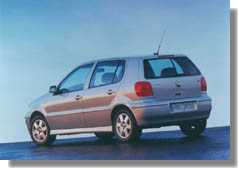
VW
POLO
Following
the launch of the new VW Polo earlier this year, Continental Cars kindly
made a 1.0 L version available to us for a drive test. On being handed
the keys, we had a good look at the car before setting off for the test.
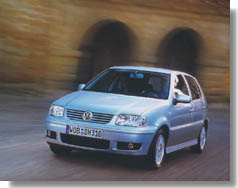 Externally,
the car bears more than a passing resemblance to its predecessor.
However, the styling of this version of VW’s ever-popular Polo makes the
previous model look dated. The light clusters have been replaced
with clear glass headlamps and revised rear clusters. The front and
rear end styling have also been revised, making the car look like a miniature
Bora from the front and a small Golf from the rear. The bumpers have
also been re-designed and now sport a bump strip, something which owners
of the previous models have frequently added to their cars to protect the
colour coded bumpers from scratches. Looking at the car from the
side, it is still clearly a Polo, however. The interior has also
been upgraded to meet current VW quality levels. The most obvious
change is the dashboard. The instruments are now housed in a binnacle,
which sits on the dashboard rather than forming a part of it, as in the
previous model. The instruments, framed in an aluminium coloured
bezel, are also illuminated in the blue light that has become synonymous
with the VW range. Externally,
the car bears more than a passing resemblance to its predecessor.
However, the styling of this version of VW’s ever-popular Polo makes the
previous model look dated. The light clusters have been replaced
with clear glass headlamps and revised rear clusters. The front and
rear end styling have also been revised, making the car look like a miniature
Bora from the front and a small Golf from the rear. The bumpers have
also been re-designed and now sport a bump strip, something which owners
of the previous models have frequently added to their cars to protect the
colour coded bumpers from scratches. Looking at the car from the
side, it is still clearly a Polo, however. The interior has also
been upgraded to meet current VW quality levels. The most obvious
change is the dashboard. The instruments are now housed in a binnacle,
which sits on the dashboard rather than forming a part of it, as in the
previous model. The instruments, framed in an aluminium coloured
bezel, are also illuminated in the blue light that has become synonymous
with the VW range.
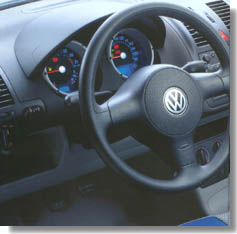
After
this brief cosmetic inspection, we set off on our test drive. The
first sensation one gets from the Polo is that even the base model can
cope very well with the adverse driving conditions we encounter every day
on our roads. The car is solidly built, something that you can feel
whilst driving along. This feeling is more pronounced than in previous
models, a result of the adoption of the latest welding technologies, which
allow increased rigidity and reduced gaps between panels. Ride quality
is very good and the car’s suspension handles well all but the very worse
potholes and bumps as a matter of course. The suspension can also
cope with a sporty driving style, reflecting VW’s commitment to quality
and safety.
Having
said that, the car we drove was equipped with fuel saver tyres. This
is a current trend with most manufacturers to provide this type of tyre,
especially on their economy ranges to improve fuel economy. 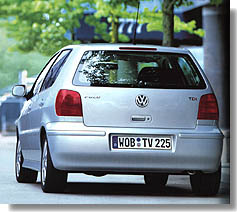 Most
of the test team from V-Dubs are strongly convinced that the improvement
in economy is provided by reducing friction between the rubber and the
road surface and this is reflected in poor traction at critical moments.
And sure enough, these tyres did not live up to our expectations during
emergency stops, further strengthening our convictions with regard to fuel
savers. Most
of the test team from V-Dubs are strongly convinced that the improvement
in economy is provided by reducing friction between the rubber and the
road surface and this is reflected in poor traction at critical moments.
And sure enough, these tyres did not live up to our expectations during
emergency stops, further strengthening our convictions with regard to fuel
savers.
With
regard to performance, the test team was divided in respect of the base
model. Mainly because part of the team is used to driving air-cooled
Beetles whilst the rest is used to more modern VWs, with turbo diesel engines
being predominantly the favourite amongst them. We all agreed the
performance is not tyre scorching, but, whereas some described it as lively,
others said it’s dead slow. The official figures are not exactly
astonishing but, bearing in mind it is powered by only a 1,000 cc engine,
the 18.4 seconds required to push this Polo to 60 mph are fairly satisfying.
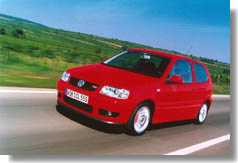 If
you like the looks of the New Polo but would like to have some more power,
you’d be glad to learn that another five engines are available to provide
some more grunt to this car. The other petrol engines available in
the Polo are the 1.4 L, the 1.4 L 16v engine, shared with the Lupo and
Golf, and the 1.6 L. The other two engines are the 1.9 SDi and the
latest diesel addition to VW’s range, the three cylinder 1.4 TDi.
This engine is by far the most economical diesel around at the moment.
But it is no slow coach. The 75 bhp that this engine provides pushes
the car to 106 mph, only requiring 12.9 seconds to get the car to a 100
kms per hour. These performance figures are not provided at the expense
of fuel economy, you’d be surely glad to learn. Equipped with the
latest generation common rail injection systems coupled with advanced engine
electronic management systems, the 64.2 mpg is by far the best economy
figures available for this type of engine. Environmentalists will
also be glad to learn that it is one of the lowest emitting engines around. If
you like the looks of the New Polo but would like to have some more power,
you’d be glad to learn that another five engines are available to provide
some more grunt to this car. The other petrol engines available in
the Polo are the 1.4 L, the 1.4 L 16v engine, shared with the Lupo and
Golf, and the 1.6 L. The other two engines are the 1.9 SDi and the
latest diesel addition to VW’s range, the three cylinder 1.4 TDi.
This engine is by far the most economical diesel around at the moment.
But it is no slow coach. The 75 bhp that this engine provides pushes
the car to 106 mph, only requiring 12.9 seconds to get the car to a 100
kms per hour. These performance figures are not provided at the expense
of fuel economy, you’d be surely glad to learn. Equipped with the
latest generation common rail injection systems coupled with advanced engine
electronic management systems, the 64.2 mpg is by far the best economy
figures available for this type of engine. Environmentalists will
also be glad to learn that it is one of the lowest emitting engines around.
By
the time we were on our way back to the Continental Garages, we’d all been
won over by the Polo. The only point on which we differed was the
engine we’d choose to power ‘our’ car. Everybody seemed to prefer
one of the more powerful engines but given the choice of a daily runabout,
the 1.0 L provides a good compromise, especially if the main use of the
car will be the school run. I would also head for my favourite tyre
dealer and swop those energy savers for something providing a bit more
grip, to enjoy some peace of mind in those critical moments we all encounter
at some time or other on our roads.
Karl
Ciarlo'
|


